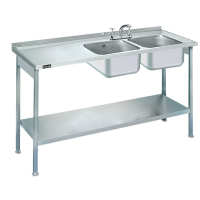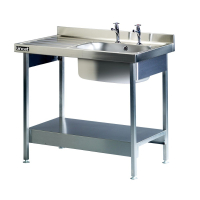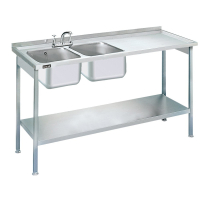Commercial Sinks
Commercial kitchen sinks are the unsung heroes of any professional kitchen setup. These robust stainless steel workhorses form the backbone of kitchen hygiene and food preparation in restaurants, hotels, and catering facilities throughout the UK. With heavy-duty construction and capacities designed specifically for high-volume use, they're worlds apart from domestic options. Available in single, double, and triple bowl configurations, these sinks pair brilliantly with dishwashers and pot washers for a complete cleaning station. After 50 years in the business, we've seen how the right sink transforms a kitchen—boosting efficiency, improving workflow, and ensuring compliance with food safety standards!
Explore More About Commercial Sinks
Get expert guidance, see real chef stories, and find answers to your most common questions.
We Recommend
Commercial Double Bowl Catering Sink | Right Draining Board | 1800 x 600 x 850mm | Modena M908-GA
- Supplied with a high-quality 16 gauge, 304 stainless steel top
- Plastic adjustable bullet feet for added stability
- Tap holes pre-punched on 7" centres (taps sold separately)
- Drainer included
- Fully height adjustable galvanised steel under shelf
-
Built-in Sink Unit | Commercial Single Sink | Right-Hand Drainer | Lincat L881 R_H
In Stock
900H x 1W x 600D mm
Lincat
£1,086.99 £2,329.80 -
Commercial Built-in Sink Unit | Double Sink | Left-Hand Drainer | Lincat L884
In Stock
900H x 1W x 600D mm
Lincat
£1,716.99 £3,679.50 -
Built-in Sink Unit | Commercial Single Sink | Left-Hand Drainer | Lincat L881
In Stock
960H x 1W x 600D mm
Lincat
£1,086.99 £2,329.80 -
Built-in Sink Unit | Double Sink with Right-Hand Drainer | Commercial Kitchen Wash Station | Lincat L884 R_H
In Stock
900H x 1W x 600D mm
Lincat
£1,716.99 £3,679.50
Commercial Kitchen Sinks for Restaurants & Catering
Brands Trusted by Industry Professionals
Key Features and Benefits
- Heavy-Duty Construction 304-grade stainless steel withstands daily kitchen battles and harsh cleaning chemicals.
- Deep Bowls Accommodates large pots and high volumes—perfect for busy kitchens.
- Hygienic Design Seamless welded bowls prevent bacteria buildup in crevices.
- Space Optimization Available with drainers and undershelf storage—maximizes kitchen real estate.
- Customizable Configurations Single, double or triple bowls with left/right drainers to suit your workflow.
- Specialized Options Dedicated hand wash stations and pot wash sinks for specific kitchen zones.
- Easy Installation Adjustable feet for leveling on uneven floors—stays rock solid.
- Compliance Ready Meets health and safety requirements for commercial food preparation.
Too busy to read? Listen instead.
In this episode of The Deep Dive, we unpack the essentials of commercial sinks—how to choose between single, double, and triple bowls, when to consider a drainer or splashback, and why sink quality and compliance matter in any professional kitchen.
16.03min | Expert-led | Real-world advice
0:00: Welcome to the deep dive.
0:02: today, forget what you think you know about kitchen sinks.
0:05: Yeah, definitely, because we're diving deep into the, well, surprisingly complex world of commercial kitchen sinks.
0:12: Our info comes from easy equipment.
0:14: They're a UK supplier doing this for what, 50 years?
0:17: That's right, half a century, and our mission really isn't just listing sinks.
0:21: It's about pulling out the crucial stuff, the insights exactly why these things are.
0:26: You know, the unsung heroes and pro kitchens, how they impact hygiene, efficiency and food safety, which is huge, absolutely fundamental.
0:34: And the cool thing is we're working from like practical stuff, right, product details, info from a supplier who actually deals with this day in day out.
0:43: Precisely.
0:43: It's not academic theory, it's ground-level knowledge.
0:46: And, you know, the first thing that strikes you is just how different these are from your sick at home.
0:52: Worlds apart, you mentioned.
0:53: Totally.
0:54: It's all driven by the sheer intensity of a professional kitchen.
0:56: OK, so let's nail it down.
0:58: What is a commercial kitchen sink, essentially?
1:01: Think of them as these incredibly tough stainless steel workhorses, right?
1:05: Their main job is handling the really demanding hygiene and food prep tasks you get in restaurants, hotels, catering, anywhere.
1:15: High volume really across the UK.
1:18: And what sets them apart from, say, my sink?
1:21: Why are they so much tougher?
1:23: It really boils down to the construction and, well, the size, the capacity.
1:27: They're engineered for constant heavy use, thicker steel, bigger bowls.
1:31: Designed for way more stuff than you'd ever throw at a domestic sink.
1:34: And it's not just one big basin usually, is it?
1:36: I picture rows of them sometimes.
1:38: often not, no.
1:39: You see single bowls, sure, but double and even triple bowl setups are really common.
1:43: Why so many bowls?
1:44: It lets you have a clear process, like wash here, rinse here, sanitize over there, separate stages.
1:50: It's crucial for hygiene.
1:51: Gotcha.
1:52: And I saw something about them working with other machines.
1:54: Yes, absolutely.
1:56: They're designed to fit right in with commercial.
1:58: Dishwashers, pot washers.
2:00: It's about creating a smooth flow.
2:01: So like a production line for cleaning, kind of, yeah.
2:04: Dirty stuff moves logically from the sink, maybe for a pre-rinse, then straight into the machine.
2:09: It speeds everything up.
2:10: So it's much more than just a basin with a tap then, it's part of the kitchen's whole system.
2:15: Exactly.
2:15: The right sink setup is honestly a cornerstone for an efficient kitchen.
2:20: It affects how smooth things run and crucially, making sure you're meeting all those food safety rules, which brings us to something that really stood out for me, just the sheer number of options.
2:30: The source lists over 50 different types.
2:32: Yeah, it's kind of amazing.
2:33: Maybe we should look at a few specific ones to get a real feel for the differences.
2:37: Good idea.
2:39: That huge range just shows how specific kitchen needs can be.
2:42: , take a single bowl like the Mona M911 GA.
2:47: OK.
2:47: Dimensions are 700 by 600 by 850 millimeters.
2:51: Decent size, good for smaller spots, stainless top, but galvanized legs, and shelf sturdy hygienic, plus a bit of storage underneath.
2:58: Right.
2:59: And then there's the Modena M902 GA wider last millimeters, and it has a left drainer.
3:04: Yeah, that drainer position seems small, but it really matters for workflow, depending on your kitchen layout.
3:09: Same bowl size and materials as the other one though.
3:11: And the Vogue DY 820, that's slightly different again, taller, 900 millimeter right drainer, and it mentions the 60 millimeter rear upstand.
3:19: yes, the upstand.
3:20: It sounds minor, but it stops water splashing up the wall, keeps things cleaner, more hygienic, clever little detail.
3:27: You wouldn't think about that at home, would you?
3:29: Not usually.
3:29: Now, look at the double bowls, the Modena M908 GA.
3:33: That's a big 1, 1800 millimeter wide right drainer.
3:36: Wow, yeah.
3:36: And notice it says 16 gauge 304 stainless steel top.
3:39: That lower gauze number means thicker steel, more durable, built to take a beating, and adjustable feet, important for wobbly kitchen floors, I guess.
3:47: Definitely commercial floors aren't always perfectly level.
3:50: Stability is key.
3:51: Then there's the Vogue DY 824, also double, 1500 millimeter wide, right drainer, but it's listed.
3:57: is lighter, 37.6 kg.
3:59: Yeah, that difference in weight could mean maybe a slightly different steel gauge or just a different structural design.
4:06: Shows how manufacturers balance, you know, toughness versus cost or maybe ease of installation.
4:11: Interesting.
4:12: It's not just size, it's the build quality too.
4:15: Exactly.
4:15: weight can be a clue and beyond these sort of standard types, you get into real specialisms.
4:21: It's like that little wall mounted one, the Modena HW 40.
4:24: Yes.
4:25: The hand wash basin, tiny compact, often comes with its own tap, not for dishes, purely for staff hand hygiene, absolutely essential.
4:33: And those janitor sinks, the Merdina JTS 700 and the B one, the mop sinks, yeah.
4:38: Some even combine a mop sink with a small hand wash basin right next to it.
4:42: Super efficient use of space for cleaning areas.
4:44: Clever.
4:45: And the Vogue GJ 537 that's listed as a pot wash sink specifically.
4:50: Right.
4:50: Built taller usually, deeper bowls, often with an under shelf for your big cleaning chemical tubs and brushes designed just for scrubbing those huge pots and pans.
4:58: We even saw sinks with built-in water heaters, the Perry ones.
5:02: Yeah, the QF 1200R and the QFSANK 1400R.
5:06: They have integrated heaters, drainers.
5:08: Great if you need guaranteed hot water right at the sink, maybe in a remote area.
5:13: And then you have built-in units, like from Lincat.
5:16: Designed to slide into a whole counter system.
5:18: So the takeaway is, it's not just about finding a sink, it's about finding the exact right sink for the job, for the space for the workflow.
5:26: Precisely that.
5:28: This huge variety exists because every kitchen's needs, workflows, and space limits are slightly different.
5:33: OK, so all this variety, all these features, why does it matter so much?
5:37: What are the real core benefits here?
5:39: Well, the foundation is that heavy duty construction.
5:42: Using 304 grade stainless steel isn't just random.
5:45: It's got this great mix of being tough, resisting rust and chemicals, and being really easy to keep clean, which is vital for food safety.
5:52: And the deep bowls you mentioned those being different from home sinks.
5:55: Critical.
5:56: You need to fit big pots, trays, lots of dishes all at once.
5:59: It makes washing faster, uses less water than doing tiny batches.
6:02: Plus, deeper bowls mean less splashing actually, less mess, less chance of spreading germs.
6:07: Exactly, which leads to hygiene.
6:10: Often they have seamless welded bowls, meaning no little cracks or joints, right, no tiny gaps where bacteria can hide and grow.
6:17: It seems like a small detail, but it makes a real difference in stopping foodborne illness, and space is always tight in kitchens.
6:24: How do these help?
6:25: Those integrated drainers are key, gives you space for stuff to air dry.
6:29: And the under shelves are huge for storage keeping cleaning stuff handy, but out of the way.
6:34: It just maximizes usable space.
6:36: And the different bowl options we talked about, single, double, triple drainer, left or right.
6:41: It lets you set up the sink station to perfectly match how your kitchen works.
6:45: No bottlenecks, much smoother flow makes sense.
6:48: And those specialized sinks, the hand wash, the pot wash, yeah, having dedicated sinks for specific tasks is much more efficient and hygienic.
6:56: You don't want staff washing hands where you're prepping food or trying to scrub giant pans in a small hand basin.
7:01: True.
7:02: What about getting them installed?
7:04: Can that be tricky?
7:05: Well, those adjustable feet we mentioned really help.
7:07: They make it much easier to get the sink stable and level, even if the floor isn't perfect.
7:12: And ultimately, they need to tick boxes for the inspectors, right?
7:15: Oh, absolutely.
7:15: Compliance is non-negotiable.
7:17: These sinks are designed and built specifically to help businesses meet all the health and safety regulations for food service, material standards, drainage, everything.
7:26: So if you're listening and thinking, OK, I need one of these, what are the absolute must consider points before buying?
7:33: Number one.
7:35: Measure your space.
7:37: Carefully, I just guess.
7:38: Definitely not.
7:39: Measure the spot.
7:40: Think about space around it for people to work, load, unload.
7:44: Think height to need a splashback.
7:46: Where's the plumbing now?
7:47: OK.
7:47: Space first, then workflow.
7:49: Yes, visualize how dishes move.
7:52: Would a left drainer or a right drainer work better for getting things to the dishwasher or drying rack?
7:57: Think about bowl configuration.
7:58: Do you need separate bowls for washing and rinsing, or one big bowl for volume?
8:03: Right, tailor it to your actual process.
8:05: Exactly.
8:06: Then materials and toughness.
8:08: The 304 steel.
8:09: Prioritize it, yes, for resisting rust and general wear.
8:12: Look at the gauge 2 lower number means thicker, tougher steel.
8:16: And bowl depth, if you're washing pots, you really want at least 300 millimeters deep, maybe more.
8:22: So pots can actually soak properly, precisely, and check the frame's strength, especially if you handle really heavy stock pots or equipment.
8:29: OK, so we've got these tough, well-designed sinks.
8:32: How do they actually work effectively in the middle of a busy service?
8:35: What makes them function well?
8:37: Well, it starts with that 304 steel.
8:39: It doesn't react with food, cleans easily, resists stains.
8:43: The deep bowls, as we said, handle volume efficiently.
8:46: And those integrated drainers stop water pooling everywhere.
8:49: Keeps the work area dryer, yeah.
8:51: And the drainage itself is designed to cope.
8:53: Bigger pipes.
8:54: Usually, yeah, wider outlets, maybe 38 millimeter, even up to 52 millimeter, connect easily to commercial waste disposals and to shift water quickly.
9:02: Fewer blockages, plus the strong frames and adjustable feet keep the whole thing solid, even when it's full.
9:08: And you mentioned hands-free taps earlier, right?
9:10: Knee or foot operated taps are becoming more common.
9:13: Why is that?
9:14: Big hygiene win reduces how much people touch the tap handles.
9:18: Especially if they've just handled raw food.
9:20: Cut down germ spread, used to be a premium thing, but the hygiene benefits are making them more standard.
9:26: Makes sense.
9:26: Now, there was a quote from an expert, Oliver Bennett.
9:29: What was his main point?
9:30: Yeah, he called the sink the unsung hero of kitchen hygiene and efficiency.
9:35: I like that.
9:36: His advice was really practical.
9:38: Invest in deep bowls and quality, durable stainless steel.
9:43: He said the kitchen porters, the people doing the hard washing work will thank you for it, especially when it gets busy, really highlights the day to day impact.
9:51: Good practical advice.
9:52: OK, let's switch gears slightly, but stay on a critical topic.
9:55: Safety.
9:56: What are the key safety guidelines when using these sinks?
9:59: Super important.
10:00: First, water temperature.
10:02: Make sure thermostatic controls are working properly on hot taps, prevents nasty scalds.
10:08: Keeps the floor around the sink dry.
10:10: Water spills happen, but cleaning them up immediately prevents slips and falls, which are really common kitchen accidents.
10:16: What about cleaning chemicals?
10:17: Store them well away from the sink area.
10:19: You absolutely don't want any accidental splashes into food prep zones, right?
10:23: Also, regularly check the seals, the plumbing connections, look for leaks.
10:27: Leaks mean wet floors, potential water damage.
10:30: And crucially strict hygiene protocols, especially after raw meat.
10:35: Absolutely.
10:36: Thorough cleaning and sanitizing the sink after any raw meat, poultry, or fish prep is vital to stop cross-contamination.
10:43: And finally, empty and clean those waste traps regularly.
10:47: Prevents blockages, stops bad smells.
10:50: OK, so that's safe usage, but how do you make sure these expensive sinks actually last?
10:54: Any top tips for longevity?
10:56: Consistent cleaning is number one.
10:58: Use no abrasive cleaners.
11:00: You don't want to scratch that stainless steel and avoid leaving acidic stuff like lemon juice or vinegar sitting in the sink for ages.
11:06: If you're washing really heavy pots, maybe use a rubber basin mat inside the sink bowl.
11:10: cushions the impact, prevents dents.
11:13: Check the waste traps weekly, just give them a quick clean out, and a little trick for keeping the steel looking good.
11:19: Occasionally polish it with a soft cloth and a tiny bit of food grade mineral oil, or even just olive oil.
11:26: Brings up the shine, adds a bit of protection.
11:28: Nice.
11:29: So, we've covered features, care, safety, but what about the bottom line?
11:34: What are the real measurable benefits for a business investing in good commercial sinks?
11:39: You can actually quantify some of this.
11:41: A well set up sink station designed for flow can genuinely cut dishwashing time.
11:46: Some studies suggest maybe up to 30%.
11:48: Wow, that's significant, and lifespan.
11:50: A good commercial sink might last 15, even 20 years.
11:54: Compare that to maybe 57 years.
11:56: For a domestic one in heavy use.
11:58: It's a much better long-term investment.
12:00: Pays for itself over time, definitely.
12:02: And think about those multi bowl sinks again, the triple ones.
12:05: Yeah, wash, rinse, sanitize all in one unit.
12:08: Save space because you might not need a separate sanitizing setup.
12:12: And honestly, just having compliant, efficient washing setups reduces your stress during health inspections, fewer issues, fewer potential fines.
12:19: We also heard from Mark, the installation expert.
12:21: What was his key message?
12:23: Mark really hammered home the value of investing in that heavy gauge stainless steel.
12:28: Thicker is better, basically.
12:31: He said, Look, the upfront cost might be a bit higher, but it lasts so much longer, potentially 5 times longer than thinner steel in a busy kitchen.
12:40: That it's actually way cheaper in the long run.
12:42: Fewer replacements, less disruption to your business.
12:45: Makes sense.
12:46: So who needs these sinks?
12:48: Is it just fancy restaurants?
12:50: Oh no, much broader than that.
12:51: Restaurants of all kinds, obviously.
12:53: They're essential.
12:54: Hotels too.
12:55: They often have huge food operations, multiple kitchens needing different sink types.
13:00: Cafes, smaller places, absolutely.
13:02: Even small cafes need efficient hygienic sinks.
13:05: It might go for compact designs, maybe single bowl with a drainer.
13:09: But still commercial grade, and catering companies need robust or sometimes even portable sink solutions for their operations.
13:16: Right.
13:17: Did we have a concrete example of a business that saw a real difference after upgrading?
13:21: Yeah, the source mentioned a place called the Riverside Bistro.
13:25: They apparently had big problems with delays in their dish pit.
13:27: Bottlenecks, exactly.
13:29: So they installed a new setup, triple bull sink, double drainers, pre-rinse sprays, waste disposal.
13:35: And it works, pretty much.
13:37: And the head chef said it made an immediate difference.
13:40: The potwash team could suddenly handle way more volume.
13:43: They reckoned they cut table turnover time by about 15% during busy periods, called it a pivotal investment.
13:49: That really shows the impact, doesn't it?
13:51: OK, let's wrap up with some quickfire questions listeners might have.
13:56: tiny kitchen, what's the best setup?
13:58: Small space, probably good quality single bowl with a drainer is your best bet.
14:02: Maximize the bowl depth if you can.
14:04: And definitely, definitely add a separate small hand washbasin, that's usually required anyway.
14:09: Daily maintenance, quick summary.
14:10: Clean daily, no abrasive cleaner, rinse well, wipe dry, optional, occasional polish with food grade oil.
14:17: The spray attachments, pre-rinse things, worth it.
14:20: Yes, big water savers, big time savers.
14:23: Gets the dunk off plates much faster before the main wash.
14:26: Improves efficiency a lot.
14:27: OK, 304 versus 316 steel, Quick difference.
14:31: 304 is great for most kitchens.
14:33: 316 has extra molybdenum, makes it even more resistant to corrosion, especially salt and harsh chemicals.
14:39: So, maybe better if you're right by the sea, or use really strong cleaners and separate hand wash sinks, really a must.
14:47: Yes, pretty much everywhere, health rules demand a dedicated hand wash basin, separate from food prep or dishwashing sinks.
14:54: It's a key hygiene rule.
14:55: Waste outlet size, what standard?
14:57: Minimum 38 millimeters for general use is good, but for pot wash sinks dealing with more debris, 52 millimeters is better to avoid clogs.
15:06: So really, whether you're in the food business or just curious about what goes on behind those kitchen doors, understanding these sinks, it's key to appreciating how complex running a safe and efficient kitchen actually is.
15:17: Yeah, it's quite insightful, isn't it?
15:18: How much thought and engineering goes into something that seems so basic, just because of the demands of that commercial setting.
15:24: OK, so wrapping up this deep dive, it's obvious commercial sinks are way more than just basins.
15:28: They're absolutely vital for hygiene, efficiency, safety in any pro kitchen.
15:32: Hm.
15:33: And the sheer range means there's a tailored solution for pretty much any need, which leaves us with a final thought for you to maybe chew on.
15:41: If something as seemingly simple as a sink requires this level of specialized design for its industry.
15:48: What other overlooked items in any industry are actually hiding a similar depth of engineering and are critical for making things run smoothly?
15:55: Yeah, maybe looking closely at this one humble piece of kitchen kit reveals just how much hidden complexity keeps our world working.
16:02: Makes you think, doesn't it?

Essential Buying Considerations
Size and Configuration
- Measure available space carefully—including height for splashbacks and drainage.
- Consider workflow: right or left drainer positioning affects kitchen efficiency.
- Multiple bowls increase productivity but require more space—balance needs with reality.
Materials and Durability
- 304-grade stainless steel offers superior corrosion resistance for longevity.
- Bowl depth matters—minimum 300mm for pot washing stations.
- Check load capacity—reinforced frameworks support heavy stock pots and pan towers.
How Commercial Kitchen Sinks Work
Commercial kitchen sinks are brilliantly straightforward but thoughtfully engineered. Constructed from food-grade stainless steel (typically 304 grade), they feature deep bowls designed to handle large pots and high volumes of dishware. Most models come with integrated drainers and splashbacks to contain water and protect walls. The drainage systems are engineered for rapid water evacuation—typically 38-52mm outlets compatible with commercial waste disposal units. Unlike domestic sinks, they're built with reinforced frameworks and adjustable feet for stability on uneven floors. Many now incorporate knee or foot-operated taps to minimize cross-contamination during busy service—perfect for maintaining hygiene standards in professional kitchens.

Trusted Insights from Oliver Bennett
![]()
Commercial Catering Equipment Specialist
12+ years experience
Safety Guidelines
- Water Temperature Check thermostatic controls—prevents scalding during use.
- Floor Conditions Keep surrounding floor areas dry—prevents slips and falls.
- Chemical Storage Store cleaning products away from sink area—avoids contamination.
- Regular Inspection Check seals and plumbing monthly—prevents leaks.
- Hygiene Protocol Clean and sanitize after raw meat preparation—stops cross-contamination.
- Waste Management Clear traps regularly—prevents blockages and odours.
Top Tips for Using Commercial Kitchen Sinks
To maximize the lifespan of your commercial sink, clean regularly with non-abrasive cleaners to prevent mineral buildup and maintain that pristine finish. Avoid leaving acidic foods (like tomatoes or citrus) in contact with the surface for extended periods. Use basin mats when washing heavy pots to prevent denting, and check waste traps weekly to prevent blockages. For stainless steel sinks, an occasional polish with olive oil on a soft cloth maintains a beautiful sheen and adds a subtle protective layer.
Benefits of Using Commercial Kitchen Sinks
- Enhanced Food Safety Designated areas for washing, rinsing and sanitizing—meets hygiene standards.
- Workflow Efficiency Proper configuration dramatically improves kitchen productivity.
- Long-Term Economy Quality units last decades—excellent return on investment.
Did You Know?
- Time Savings Properly configured sink stations reduce washing time by up to 30%.
- Longevity Commercial-grade stainless steel sinks typically last 15-20 years—three times longer than domestic models.
- Versatility Triple-compartment sinks eliminate the need for separate sanitizing equipment—space saver.
- Compliance Value Proper hand wash stations reduce health inspection issues by over 40%.




Expert Insights on Commercial Kitchen Sinks
After fitting thousands of commercial kitchens, our installation team knows sinks inside out. 'The sink station is ground zero for kitchen efficiency,' explains Mark, our commercial kitchen specialist. 'We always recommend investing in the heaviest gauge stainless steel you can afford—it's the difference between replacing a sink in 3 years versus 15 years in high-volume operations.'
- Pros: Durable, hygienic, configurable to specific kitchen needs.
- Cons: Quality models require investment—cheaper options often need early replacement.
Who Needs Commercial Kitchen Sinks?
- Restaurants Essential for prep, pot washing and meeting hygiene regulations.
- Hotels Multiple units required throughout kitchen zones for efficient service.
- Cafés Compact units with drainers maximize limited kitchen space.
- Catering Companies Mobile and fixed units support diverse operational needs.

Real-World Success with Commercial Kitchen Sinks
The Riverside Bistro in Bristol underwent a complete kitchen overhaul last year after struggling with an inefficient washing area. They installed a triple-bowl stainless steel sink unit with drainers on both sides, paired with pre-rinse spray units and waste disposal systems. 'The transformation was immediate,' says head chef James. 'Our pot washing team can now process three times the volume without the chaos. Ticket times are down 15% simply because we've sorted the washing station properly. Best investment we've made!'

FAQs
- What's the best sink configuration for a small commercial kitchen? Single bowl with drainer works well—add a hand wash station if space permits.
- How do I maintain commercial stainless steel sinks? Clean daily with non-abrasive cleaner and polish occasionally with food-grade oil.
- Are pre-rinse spray attachments worth adding? Absolutely—they reduce water usage and speed up pot washing significantly.
- What's the difference between 304 and 316 grade stainless steel? 316 offers better corrosion resistance—ideal for coastal locations or heavy chemical use.
- Do I need separate hand wash sinks? Yes—health regulations require dedicated hand washing facilities in food prep areas.
- What size waste outlet do commercial sinks need? Minimum 38mm diameter—larger 52mm for pot wash sinks prevents blockages.
Looking for Equipment by Business Type?
Not sure where to start? Whether you're running a bustling café, opening a pizzeria, or managing a school canteen, we've made it easy to shop by business type. Explore handpicked equipment bundles and essentials tailored to your industry—saving you time and making sure you get exactly what you need.
Other Categories You Might Find Useful
We’ve selected some closely related categories that might be essential for your setup. Whether you’re expanding your kitchen or just making sure you’ve got everything covered, these links will help you explore more equipment that fits your needs.
What our Customers Say
'Transformed our kitchen workflow—robust build quality that's clearly built to last!'
M Mike Head Chef, The Golden Spoon, Leeds'Brilliant sink unit—perfect depth for our large stock pots and incredibly easy to keep clean.'
C Charlotte Kitchen Manager, Bayside Hotel, Brighton
Why Choose EasyEquipment for Commercial Kitchen Sinks?
- Trusted Supplier 50 years supplying commercial kitchens—we know sinks inside out.
- Fast Delivery UK-wide delivery with installation options—get up and running quickly.
- Best Price Promise Found the same sink cheaper? We'll match it—guaranteed value.
- Expert Guidance Free kitchen planning advice—get the perfect configuration first time.
Ready to Explore Commercial Kitchen Sinks?
Discover our complete range of commercial sink units designed for professional kitchens of all sizes. From compact café solutions to industrial-grade systems for large restaurants—find the perfect configuration with our expert guidance and fast UK delivery.
#CommercialSinks
- #KitchenEquipment
- #CateringSinks
- #RestaurantSupplies
- #StainlessSteel
- #FoodSafety
- #ProfessionalKitchen





